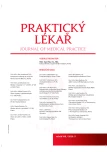Hypercholesterolemia therapy by PCSK9 inhibitors
Authors:
M. Nesvadba 1,2; P. C. Cmorej 3,4; M. Vostrý 4
Authors‘ workplace:
Ordinace praktického lékaře, Turnov
1; Vysoká škola zdravotníctva a sociálnej práce sv. Alžbety v Bratislave, SR, Rektor: Dr. h. c. prof. MUDr. Vladimír Krčméry, DrSc.
2; Zdravotnická záchranná služba Ústeckého kraje, p. o., Ředitel: MUDr. Ilja Deyl
3; Univerzita J. E. Purkyně v Ústí nad Labem, Fakulta zdravotnických studií, Děkan: doc. PhDr. Zdeněk Havel, CSc.
4
Published in:
Prakt. Lék. 2020; 100(1): 34-36
Category:
Case Report
Overview
PCSK-9 inhibitors are a new, subcutaneously applied, highly efficient and well tolerated lipid lowering treatment, currently available with two active substances – evolocumab and alirocumab. The lipid lowering effect of both of them is very similar, in clinical trials they led to LDL-cholesterol reduction by 50–60%, not only in trials where PCSK-9 inhibitors were added to high-dose statin treatment (FOURIER, ODYSSEY OUTCOMES), but also in trials where patients with statin intolerance (GAUSS-2,3, ODYSSEY ALTERNATIVE) who either did not use statins at all, or only in small doses were included. The following article describes the case-reports of one high-risk patient in secondary prevention of cardiovascular disease suffering from partial statin intolerance, in who the addition of PCSK-9 inhibitors led to a significant LDL-cholesterol reduction, achieving the LDL-cholesterol target value and thereby lowering cardiovascular risk.
Keywords:
evolocumab – statin intolerance – PCSK-9 inibitors
Sources
1. Collins R, Reith C, Emberson J, et al. Interpretation of the evidence for the efficacy and safety of statin therapy. Lancet 2016; 388(10059): 2532–2561.
2. Pella D, Gvozdjakova A, Lietava J, a kol. Myopatie asociovaná se statiny: klinické doporučení Slovenskej asociácie aterosklerózy a České společnosti pro aterosklerózu. Athero Review 2016: 1(1): 7–13.
3. Robinson JG, Nedergaard BS, Roger WJ, et al. Effect of evolocumab or ezetimibe added to moderate- or high-intensity statin therapy on LDL-C lowering in patients with hypercholesterolemia. The LAPLACE-2 randomized clinical trial. JAMA 2014; 311(18): 1870–1882.
4. Sabatine MS, Giugliano RP, Keech AC, et al. Evolocumab and clinical outcomes in patients with cardiovascular disease. N Engl J Med 2017; 376(18): 1713–1722.
5. Cannon CP, Blazing MA, Giugliano RP, et al. Ezetimibe added to statin therapy after acute coronary syndromes. N Engl J Med 2015; 372(25): 2387–2397.
6. Mancini GB, Baker S, Bergeron J, et al. Diagnosis, prevention and management of statin adverse effect and intolerance: Canadian Working Group Consensus Update (2016). Can J Cardiol 2016; 32(7 Suppl): S35–65.
7. Gupta A, Thompson D, Whitehouse A, et al. Adverse events associated with unblinded, but not with blinded, statin therapy in the Anglo-Scandinavian Cardiac Outcomes Trial – Lipid Lowering Arm (ASCOT-LLA): a randomized double blind placebo-controlled trial and its non-randomized non blind extension phase. Lancet 2017; 389(10088): 2473–2481.
8. Stroes ES, Thompson PD, Corsini A, et al. Statin associated muscle symptoms: impact on statin therapy – European Atherosclerosis Society consensus panel statement on assessment, aetiology and management. Eur Heart J 2015; 36(17): 1012–1022.
9. Schwartz GG, Steg PG, Szarek M, et al. Alirocumab and cardiovascular outcomes after acute coronary syndrome. N Engl J Med 2018; 379(22): 2097–2107.
Labels
General practitioner for children and adolescents General practitioner for adultsArticle was published in
General Practitioner

2020 Issue 1
Most read in this issue
- Patients with limited legal capacity in general practitioners’ surgeries: what is new in Czech legislation
- Using honey dressing in treatment of non-healing wounds in elderly
- Pelvic venous congestion syndrome in clinical practice of angiologist’s point of view
- Hypercholesterolemia therapy by PCSK9 inhibitors
